Trees add substance and interest to a garden
Which fruit trees grow well in the UK?
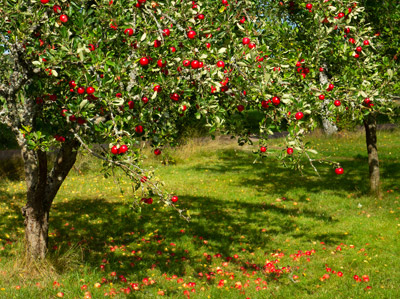
Which Fruit Tree?
Fruit trees are a great addition to any garden, they produce blossom in the spring and delicious fruits later on. You can plant trees to produce fruit of varieties and almost certainly a quality it can be almost impossible to buy. Many of them grow into gnarled characterful trees from a fairly early age too.
Tree fruit generally doesn't come true from seed so particular varieties are grafted onto rootstock that determines the eventual vigor and size of the tree. There's little point in trying to grow tree fruit from seed for your garden, it will work but will almost certainly be a worse quality of fruit than you'd get buying a named variety where someone else grew thousands of trees and selected out the few best ones for you. It will also take several years until you find out what you'll get.
One thing that should be understood about many fruit trees is that the are two components to the tree, the rootstock and the top growth which come from what were originally two different plants. The top growth is the variety it is chosen for its fruiting qualities, this is grafted onto the rootstock which is chosen for vigour, hardiness, disease resistance etc., the rootstock will determine the size the tree will ultimately grow to.
Step 1 - choose the variety Step 2 - choose the size (rootstock)
The same fruit variety can be available on a variety of rootstocks to give different sizes at maturity and rates of growth. There are a number of options from "very dwarfing" rootstocks that may allow the tree to be grown in a container, to "extremely vigorous" where you'll need a ladder to reach much of the fruit. Most nurseries will sell fruit trees grafted onto "dwarf" or "semi-dwarf" rootstock which are relative phrases, dwarf trees will be 7-10 feet tall at maturity with semi-dwarfs about 12-14 feet tall.
Plums, Damsons, Greengages and Mirabelles - These are all cultivars derived from the European Plum, Prunus domestica. If I only had room for one tree, I'd get a plum or one of these close relatives. They are good trees in their own right, their fruit tends to be relatively expensive as they don't travel so well or keep for very long, and they are very delicious. The nicest fruit I have had in my life was a greengage eaten straight from the tree and warm from the sun in a small Cambridgeshire orchard. It was the first greengage I'd ever had and I couldn't believe that this small unassuming green plum could be so sweet and flavoursome, several more quickly followed. In some parts of the world plums are regarded as an "exotic fruit", proper plums that is, thin skinned, plump and soft with sweet, juicy, tender flesh, not the thick skinned never-quite-ripe drinks of water that supermarkets select for travel resilience and shelf life. Plum trees are generally fairly small, and aren't as bothered about pruning in the way that apples or pears are, so there's little to do once they are growing well. They will grow on most soils but will struggle or fail if it is frequently very wet or becomes waterlogged. Their only vulnerability is that they flower early in the spring and the blossom may be damaged by frost reducing that years crop. Birds may eat the blossom which can also affect the crop, I'm fortunate in that there's only a pair of collared doves that get at mine and I can live with the limited damage that they do. Many plums are not self-fertile other than the admirable "Victoria" variety, and increasingly some newer types, though given their size it is not too difficult to have 2 or 3 for cross-fertilization in the same garden. The self-fertile varieties will usually crop more heavily and reliably with a pollination partner tree. Training and pruning - Being drupes (stone fruits) plums should not be pruned in the winter months as this makes them susceptible to the fungal disease silver-leaf. They should be pruned when in leaf and growing, pruning off fruit that is forming won't harm the tree but you lose the fruit that is forming so the best time is immediately after fruiting in late summer while the tree still has leaves on. The bush form is the easiest to maintain and most effective in the average garden. Over the first three years an open crown with four strong branches should be allowed to develop. Pruning needs only to remove obvious shoots and branches that are damaged, too thin and long, crossing or in the wrong place. 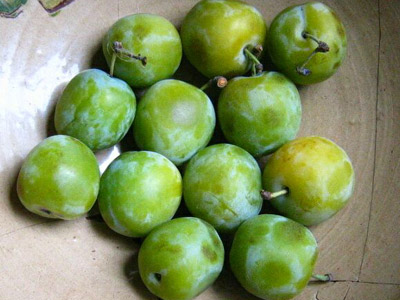 Greengages ripen from early to mid-August, they are mostly still green even when fully ripe, though may develop a yellow tinge where the sun catches them. 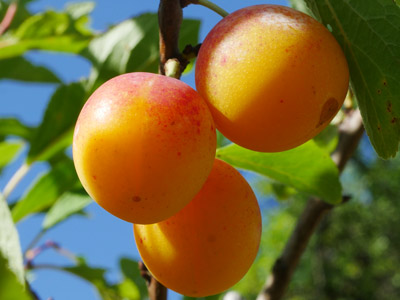 Mirabelles are small yellow to red plums closer to the native kinds than most cultivated varieties, they have a particular delicious and delicate flavour of their own but are not as prolific as cultivated varieties. Plums are the best option for a good crop of fruit, though there are also greengages and mirabelles which are similar. These generally don't crop as heavily as plums which not be an issue if you don't need or want large amounts of fruit. Greengages are the best of these to my mind (and taste buds), the trees grow more quickly and larger than plums but the crops aren't as heavy or reliable, the fruit is divine. Straight off the tree is best and while the season is short they can be preserved as delicious jam or even better frozen in a light syrup after halving and stoning to use in crumbles through the winter. Mirabelles (aka cherry plums) are small delicious plums much grown and prized in the Lorraine where Tarte aux mirabelles is the traditional way to eat them. They are best eaten straight off the tree and also make delicious jam. The trees are prolific in the numbers of fruit but as they are small the weight of the harvest will be less than a comparable plum tree. Damsons are generally smaller trees and amongst the least effort and hardiest of any in this group. The fruit is small, dark purple-black with an attractive bloom and so intensely tart you'll probably only try one straight from the tree once. They are excellent in cooking however and make one of the best jams, they can also be used for damson cheese (nothing dairy about it but very good with actual cheese), damson gin (like sloe gin), crumbles, pies etc. Plum trees to buy Plums are grafted onto a rootstock which determines their ultimate size, with the grafted portion being the particular variety of plum. Suckers may be produced from below the graft junction which should be removed as seen.
|
Apples - England is the best place in the world to grow apples and we have the greatest number of varieties, 2,500 from a world total of about 7,000, more than any other fruit. They can be planted in any kind of soil. 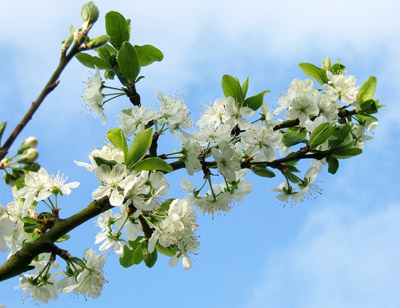
Apples are easy to grow and wildlife friendly, they need a sunny position to get a good crop, it should be as sheltered as possible too. If you live in an area with late frosts, select late flowering varieties. If you have space for more than one tree you can have a crop of apples ripening from mid summer to late autumn. They will produce fruit in 3-5 years after planting. No apples are consistently and reliably self-fertile where possible, they should always be planted with other varieties that flower at the same time to ensue cross-pollination and so achieve better fruit set. These pollination partners do not need to be in your garden however as bees will fly several hundred metres between different trees all day long, so they could be your neighbours trees even several doors down. Apples grow naturally to a shape which is called the "bush" form, they can however also be easily gown in a variety of other forms, such as fan, espalier, cordon as a stand-alone (supported) 2-D shape or grown flat against a wall. The bush is the most useful shape for most gardens, a little formative pruning helps in the early years to shape the tree for later on. The aim is to achieve an open crown with 8-10 branches radiating from a short trunk.
Initial training removes the leader to just above 3 or 4 strong lateral (side pointing) buds, over the next three years, a network of laterals should be encouraged to produce the required 8 - 10 branches. Other branches not selected for the main ones should be pruned to just 4-5 buds in length, The strong laterals should have about 1/4 of the seasons growth cut from them at this time. All cuts should back to outwards pointing buds so that shoots don't cross over. Subsequent pruning of mature trees in gardens is to prevent damage from crossing shoots that will rub against each other, to remove any dead or damaged wood and prevent any shoots taking over from the main branches. Fruiting spurs should ideally be kept back to 4-6 buds in length. Allowing longer fruiting spurs will run the risk of them breaking under the weight of the fruit which will damage the shape of tree and allow disease in. Over time apple trees can grow quite long thin branches that fruit heavily leading to damage. Restorative pruning of neglected trees, should take place over 3 or 4 years if possible. If a tree has been neglected for some time, it will have long pendulous branches that bend considerably under the weight of fruit and some may already have broken. Cut any that have broken to a point before the break so the tree can form a clean wound seal. Cut back no more than 1/4 - 1/3 of the elongated branches in any one year to no less than 1/2 of the previous length (unless removed altogether due to disease or damage). The tree will probably produce a large number of vigorous shoots in response - many where you don't want them to be. These should be removed or encouraged as appropriate. Apple trees to buy - More Apples Rootstocks, look out for these when buying an apple tree, it will determine how big it will get, the variety name doesn't tell you this, though there may be some size differences between different varieties on the same rootstock..
|
Pears - Pears make good ornamental trees as well as providing fruit. They have decorative furrowed bark and do a really good line in old-and-gnarly from a relatively young age. The blossom is very decorative and plentiful in the spring and there are many varieties that give good autumnal colour too.
Wall training shows off their attributes very well, one of my neighbours has a pear about 15ft high and wide trained onto the wall at the side of his house and it looks good pretty much all through the year and incidentally is over a hundred years old. Pears are best regarded as not being self-pollinating. Some are (sort of) but almost all do better when they have a pollination partner. The variety "Conference" can form almost banana shaped fruits when self-pollinated for instance, but reverts to the usual pear shape when cross pollinated. Others varieties don't set fruit hardly at all without a pollination partner. A pollination partner may of course be in one of your neighbours gardens. Training and pruning - pears should be pruned while dormant in the winter months, the best time is after the harshest of the winter weather is over, but before the buds break for spring. Winter pruning should be to thin out the fruiting spurs while maintaining a network of larger branches to promote younger growth without becoming overcrowded. As a rule of thumb you should be able to put your outstretched hand between the twigs and branches of your pear (or apple) tree. Fruit thinning may be required sometimes as a very heavy crop may be set. Partridges optional. Pear trees to buy Rootstocks, look out for these when buying a fruit tree, it will determine how big it will get, the variety name doesn't tell you this.
|
|
Other Tree Fruit -
Apples, plums of various kinds and pears all grow well
and fruit reliably in the UK and are popular straight
from the tree, cooked or preserved. There are of course
other kinds of tree fruit that are less commonly grown,
this may be because they are more difficult to grow,
less reliable in fruit production or the fruit needs
cooking or preserving in various ways. Here are a few
you may consider for your garden or small orchard.
Fruit trees to buy Cherries - There are two distinct types sweet and acid. Sweet cherries can be eaten directly from the tree, the acid cherries are used for cooking and preserving. Both are hardy though in most of the UK, they will not ripen fully unless they are in a very sheltered sunny spot, the best way to do this is to fan train the tree against a sunny wall (ideally about 8ft tall and 25ft wide). This form is also easiest to net against birds taking the fruit. In many locations if this is an absolute requirement if you are to taste any of your fruit yourself, birds will happily take the fruit long before it's fully ripe. Sweet cherries need another compatible cherry tree nearby for pollination. "Patio" cherries on dwarfing rootstock are available and can be protected on a sheltered sunny patio, courtyard or similar where they can be grown in large containers. Acid cherries are much easier to grow in a cool climate and also in a small garden. They are less vigorous than sweet cherries and being mostly self-fertile have no need of another tree for cross pollination. If you don't net it however, you are again likely to lose the fruit to the birds that will take them before they ripen fully. Quince - A tree that is easy to grow as long as it is in somewhat moist conditions, they don't like soils that dry out too much in the summer. Once established quince trees can be very productive of large flavoursome fruits that have almost been forgotten about nowadays. The fruit are bitter and inedible straight from the tree and must be cooked before eating, in particular they make lovely jams and jellies or can be cooked in tarts on their own or as an addition to apples in pies and the like. Medlar - Another easy to grow and very handsome tree with an unusual fruit that was once fairly common, though now is hardly grown at all. The unlikely looking fruits are stored for a few weeks after picking and are ready to use when they have apparently become rather too ripe, a process known as "bletting". They can be used in mixed fruit pies or puddings and make excellent jellies to go with cheese and cold meats. Crab Apple - Crab apples are even easier apple trees, they don't need the attention to pruning that apples do, they produce masses of blossom, loads of decorative small fruits and often a show of autumn leaves too. They are excellent ornamental trees for gardens much loved by bees for the nectar and birds for the fallen fruit. The fruit cannot be eaten straight from the tree even when ripe, you'll need to process it into a jelly, butter, syrup etc. to make it edible which makes it delicious. Peaches and Nectarines - are respectively downy and smooth skinned versions of the same fruit Prunus persica. Most forms are self-fertile, they prefer warmer conditions, nectarines even more so than peaches. In most of the UK the protection of a sunny wall and / or protection under glass is required, training as a fan is usually the preference. They flower in the early spring and are susceptible to frost. There are few pollinators around at this time so hand pollination, especially under glass is advisable. Fruit thinning may often be necessary as conversely if conditions are good, then peaches will set fruit very heavily. Leaving them unthinned means they are more susceptible to rots and infection and the greater number of fruits are smaller and less satisfactory. |
Picture credits:
Apple tree top of page - W. carter, used under Creative Commons CC0 1.0 Universal Public Domain Dedication license / Greengage - public domain / Mirabelles - Helge Klaus Rieder, used under Creative Commons CC0 1.0 Universal Public Domain Dedication license / Damson - Dinkum, used under the Creative Commons CC0 1.0 Universal Public Domain Dedication /Cox's Orange Pippin - Andreas Rother, used under the Creative Commons Attribution-Share Alike 2.5 Generic license / Laxton's Superb - Jorgens.mi, CC BY-SA 3.0 / Bramley - Joybot, used under the Creative Commons Attribution-Share Alike 2.0 Generic license / Conference Pear - Glysiak, used under the Creative Commons Attribution-Share Alike 4.0 International, 3.0 Unported, 2.5 Generic, 2.0 Generic and 1.0 Generic license / Pear Buerre Hardy - Helge Klaus Rieder, used under the Creative Commons CC0 1.0 Universal Public Domain Dedication / Red William - Mleprince, used under the Creative Commons Attribution-Share Alike 3.0 Unported license / Pear, "Beth" - Acabashi, used under Creative Commons Attribution-ShareAlike 4.0 / Cherries - Ermell, used under the Creative Commons Attribution-Share Alike 4.0 International license / Medlar - Andrew Dunn, used under the Creative Commons Attribution-Share Alike 2.0 Generic license / Quince - Suhayl091, used under the Creative Commons Attribution-Share Alike 4.0 International license/ Peach - myself, used under the Creative Commons Attribution 3.0 Unported license / Nectarine - Jeremy Keith, used under the Creative Commons Attribution 2.0 Generic license / Four pears, Rhododendrites, used under Creative Commons Share Alike 4.0 International license.
Copyright 2000 - present. All Rights Reserved | Privacy Policy Statement

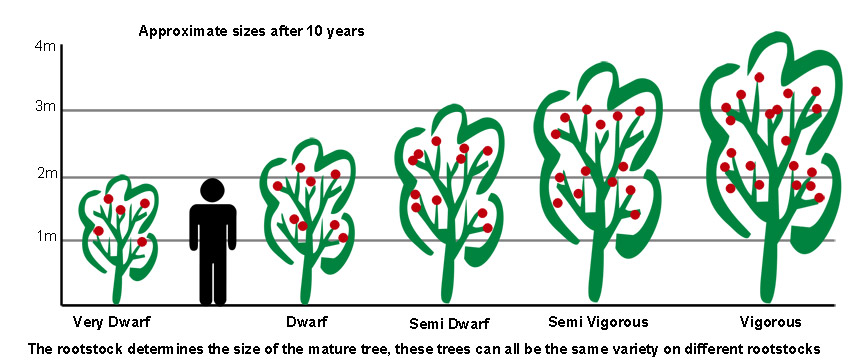


 Victoria Plum
Victoria Plum Greengages
Greengages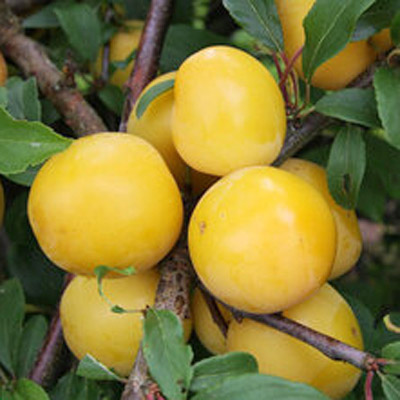 Mirabelles
Mirabelles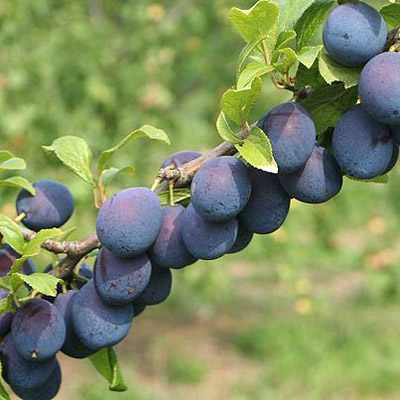 Damsons
Damsons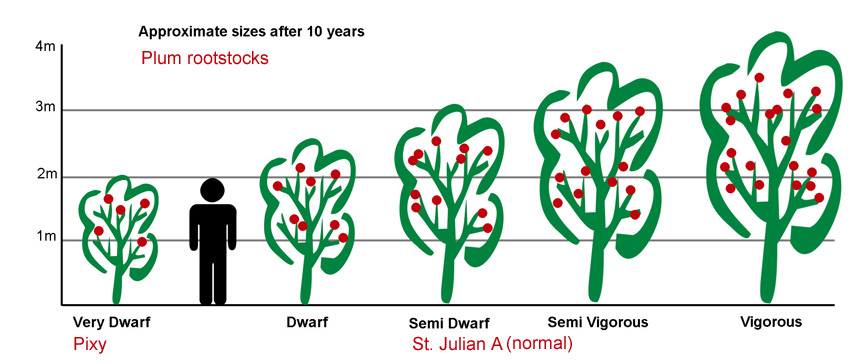
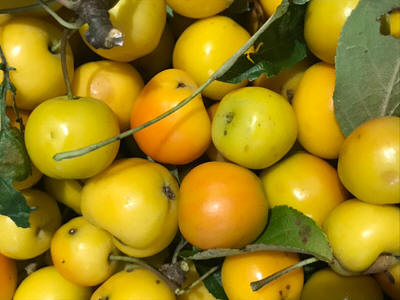
 Cox's
Orange Pippin, widely regarded as the tastiest
of all apples
Cox's
Orange Pippin, widely regarded as the tastiest
of all apples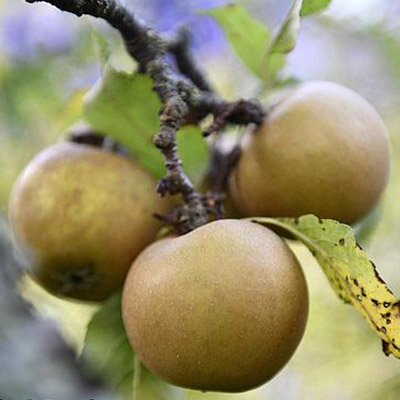 Egremont
Russet, eating apple
Egremont
Russet, eating apple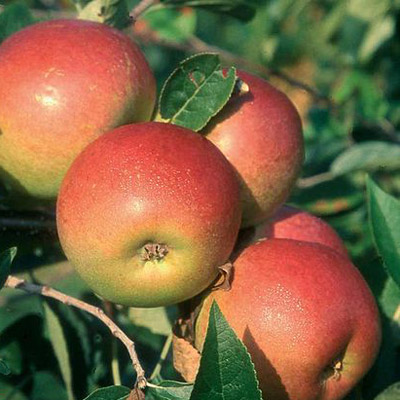 Laxton's
Superb, old fashioned dessert apple
Laxton's
Superb, old fashioned dessert apple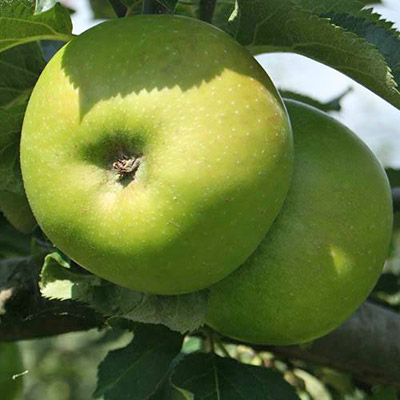 Bramley cooking apple
Bramley cooking apple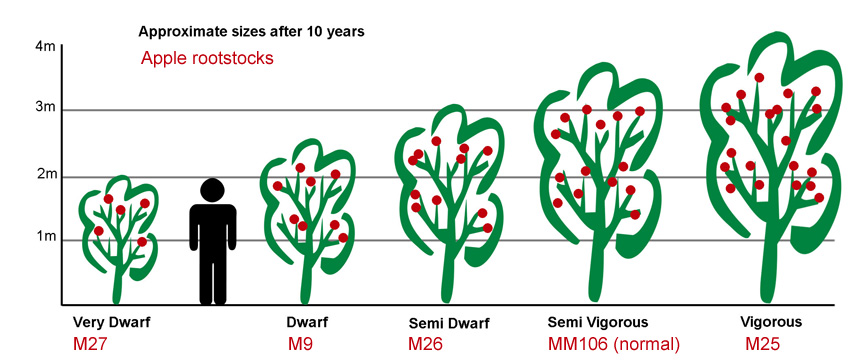
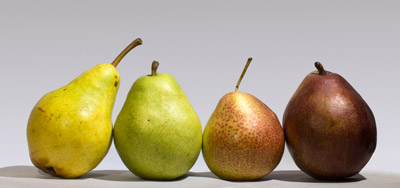 Pear
trees are very similar to apples but are a little more
demanding, they need more sheltered, warmer conditions
in the growing season and in particular when flowering
which happens earlier, so if you have both apples and
pears give the pear tree the best spot.
Pear
trees are very similar to apples but are a little more
demanding, they need more sheltered, warmer conditions
in the growing season and in particular when flowering
which happens earlier, so if you have both apples and
pears give the pear tree the best spot.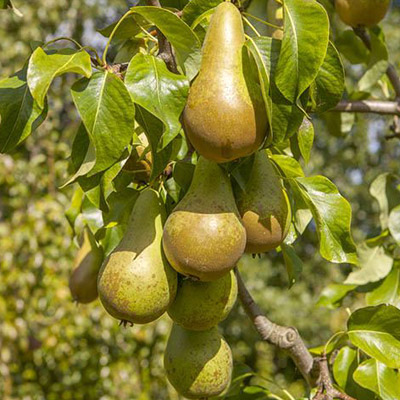 Conference, self-fertile, UK's most popular
eating pear
Conference, self-fertile, UK's most popular
eating pear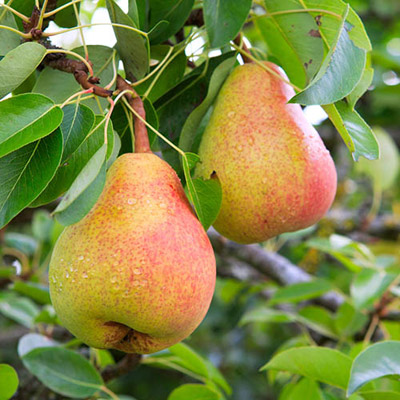 Beurre
Hardy, late fruiting, very juicy!
Beurre
Hardy, late fruiting, very juicy!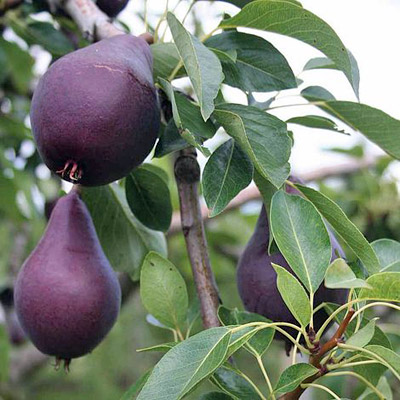 Red
William, red version of a popular variety
Red
William, red version of a popular variety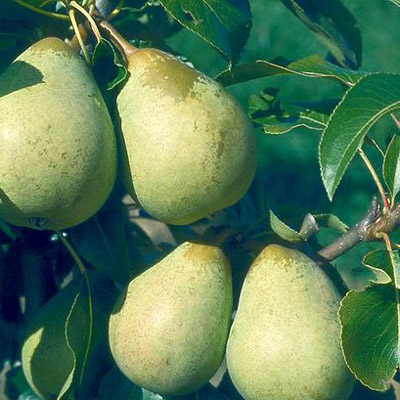 Beth,
dessert pear, heavy cropping and reliable
Beth,
dessert pear, heavy cropping and reliable
 Cherries
Cherries Medlars
Medlars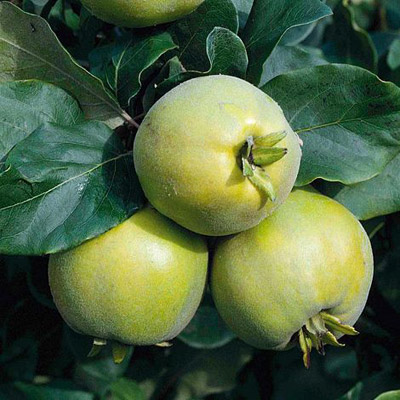 Quince
Quince Crab
Apples
Crab
Apples Peaches
Peaches Nectarines
Nectarines